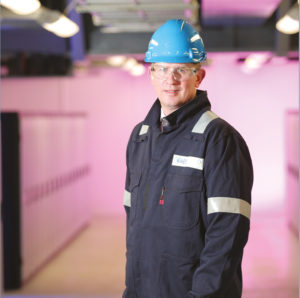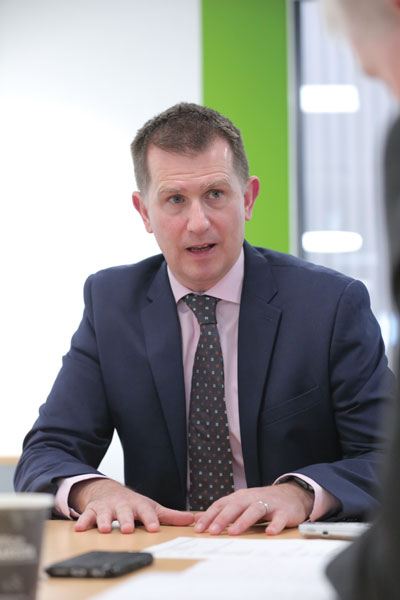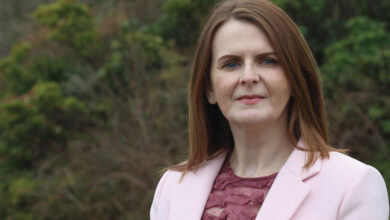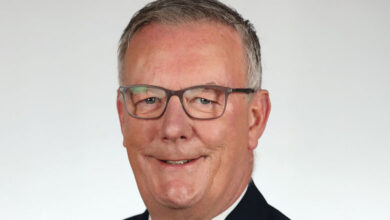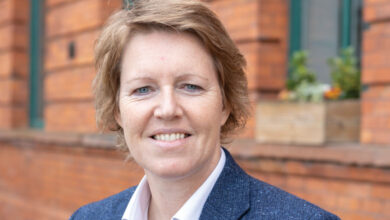Powering the transition
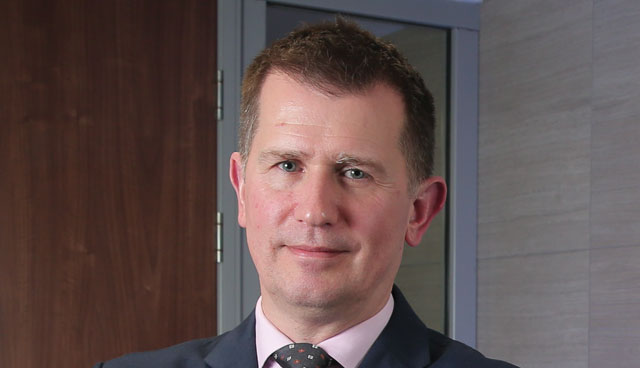
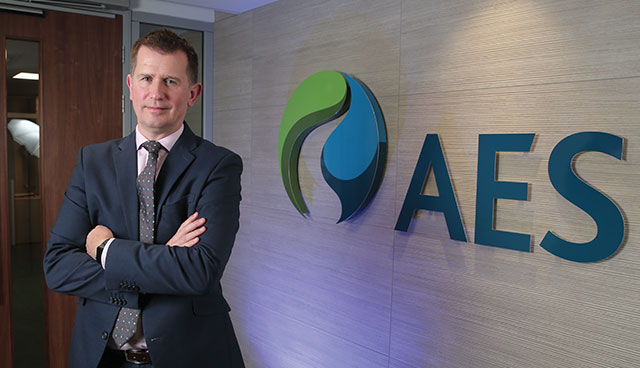
President of AES UK and Ireland, Ian Luney, discusses adapting to disruption of the global energy market, aiding the renewable transition and how challenges in Ireland are being met with new solutions.
“A lot of people don’t know this but Northern Ireland was actually AES’s first foreign direct investment outside of the US in 1992,” highlights Luney, who took up the role in June 2017 having served as AES Europe’s Chief Commercial Officer.
The American multi-national, active in five regions across the world, bought out its Belgian partner company in 2000 to take full control of the Kilroot power station and cemented its place as Northern Ireland’s largest electricity generator in 2010 by taking over Ballylumford.
Outlining the solely power production company’s business model in Northern Ireland, Luney says: “Primarily we are about providing safe secure energy to our customers. The market is changing and our role is changing. We aim to be a transitional player, aiding the switch from the utility-model mindset to an energy market that is increasingly defined by disruption in the form of renewables and digitisation.”
In 2016 the company generated 11 per cent of energy across the all-island electricity system, representing 61 per cent of dispatchable generation capacity in Northern Ireland. However, recent years have seen large drops in profits, owing to greater diversity in the energy market.
This diversity, explains Luney, is made up of both local factors and those being recognised in energy markets on a global scale.
Highlighting the universal challenges, he says: “We are seeing a transformative change in the downwards costs of renewable technology, particularly onshore wind, meaning renewables are now competing on a level-playing field with existing generation.
“Disruption to the market is coming from several angles including greater customer empowerment and from smart grids and aggregated distribution that are now starting to make an impact spurred on by the advent of better technology. New players are coming to the market with a different mindset to the existing way of working and across the globe AES is embracing these innovations.
“We are also seeing an ongoing exposure to a drive towards competitive merchant markets, making the securing of long-term power purchase agreements harder. The wholesale market is competitive and there is an exposure to commodity prices. Volatility swings of those prices has the ability to push generators in and out of merit order in the electricity market and this can have a profound impact on their commercial viability year on year.”
Locally, he outlines that uncertainty around I-SEM and Brexit that are occupying the minds of the sector in Ireland.
“The aims and objectives of I-SEM are correct in terms of facilitating more competition, providing proper entry and exit signals and creating a European-wide market. However, the challenge we face is the year-on-year uncertainty for those of us who are not new entrants.”
“The strategic energy framework is crucial for setting the road map for the future and what generation mix is required.”
Luney explains that commodity price exposure, coupled with one-year only capacity markets and the ongoing restructuring of the ancillary services market arrangements (DS3) has been challenging.
“It has been a much more fragmented approach compared to what had been going on with energy capacity payments and it has made it difficult to provide for the long-term basis for running a business, particularly one which has significant capital requirements. Recovering fixed costs in a very competitive market will be difficult.”
The situation in Northern Ireland has not been helped by the lack of an Assembly, and particularly the absence of a strategic energy framework. Luney says: “The strategic energy framework is crucial for setting the road map for the future and what generation mix is required. Also, the framework is a critical part in enabling an industrial strategy, attracting FDI and attempting to rebalance the economy. If we don’t have a robust, resilient and cost-effective energy market and system then Northern Ireland will struggle to compete on an international stage.”
While greater competition in the market has its many advantages, Luney warns against creating an environment where security of supply is put at risk, at least in the short-medium term until the second North South Interconnector is operational.
“We need to ensure that we don’t force out generation that is required to ensure that security of supply. There is a security of supply issue not just for Northern Ireland but also for the greater Dublin area, which has witnessed an influx of data centres but there is a lack of infrastructure to evacuate power in and out of the city. As we move towards a more competitive energy landscape, we need to make sure that the right mechanism is in place to ensure the security of supply is still maintained, however regulators and governments want to do that.”
“We need to ensure that we don’t force out generation that is required to ensure that security of supply.”
Getting the balance right
Historically the energy trilemma incorporated security of supply, cost to customers and decarbonisation. However, dramatically increased levels of customer empowerment in recent years is now not only an addition to the trilemma but many believe it is driving market behaviour.
Increased customer choice has seen an increase in the volume of people going off grid with new innovative energy solutions such as smart metering and smart homes. It has also opened the door for the potential of large IT companies to enter into the energy sector.
Luney believes that AES’s unique portfolio of fuel diversity in power generation is well placed to accommodate customer-driven demand. At Ballylumford the power provider operates a combined cycle gas turbine (CCGT), with renovated thermal gas-fired units acting in reserve to address any security of supply issues.
At Kilroot AES operates duel-fired oil and coal units, the only coal-fired power station operating in Northern Ireland, and recently installed what was the UK’s largest battery energy storage facility (10MW) from January 2016 to July 2017. Across both sites the provider also operates a fleet of open cycle gas turbines (OCGT) with fast-start, fast-ramp capability.
Highlighting the importance of operating diversity in the Irish energy market, Luney points to the potential vulnerability of the Moffat compressor station, providing a common point for gas coming from Scotland. “If there is any failure in that line then Ireland is in problems, so we provide a really good counter point to gas.”
The market changes mean AES has had to think differently. One of the ways in which it is achieving this in other global markets, and now integrating into the Irish market, is collaborating with transmission and distribution companies, “helping utilities and regulators think differently about how they invest in their asset base”.
Luney says: “Building new large-scale projects is difficult as often these projects run into a lot of objection. What we are looking to do is offer support in leveraging and working the assets that exist today better and more efficiently to ensure that big infrastructure developments aren’t met through cost to customers. We are encouraging people to think more creatively across the piece on what solutions exist.”
The two ageing power stations, in their current format, have a limited lifespan. At Kilroot, competitive pressures around carbon pricing and environmental legislation mean that it was always going to be unlikely that the station would be repowered in its current format. Uncertainty over I-SEM and Brexit also means that such large-scale investment would be risky.
However, as Luney explains there is still a need for and potential in the sites: “We acknowledge our ageing fleet and so I see my job as taking what we have today and using it to aid the market. We have the capacity to help customers and stakeholders in the transition to the decarbonisation of the energy sector but also to provide new solutions like energy storage and high efficiency peaking units to make sure the market can facilitate the integration of renewables.”
“The market needs to incentivise flexibility. Our concern would be governments, regulators and TSOs are very slow in moving in that direction.”
He explains that AES is not considering any diversion away from solely power generation and storage, instead the company are focussed on their strategy of transitioning the market before considering repowering either both or one of the sites with technology which is fit for purpose in the long-term, for a market which is dominated by renewables and interconnection.
He admits that it is unlikely this will take the form of another CCGT, instead early indications suggest space for hybrid, fast-start, highly efficient peaking unit, with energy storage attached. “We are looking at things like this to as a means to try and create that sustainable energy market here in Ireland, where wind and solar could have a massive impact on how units are dispatched.
“The market needs to incentivise flexibility. Our concern would be governments, regulators and TSOs are very slow in moving in that direction.”
In the meantime, Luney says: “We’ll continue to get ready for I-SEM and build a commercial platform to try and help the smaller participants in that new market.” Outlining that I-SEM will create hurdles for market access for smaller participants, he adds: “We can offer our platform on a third-party services basis to small aggregators. As an independent power producer, we hopefully offer a different angle than those with a retail perspective.”
AES Corporation in Northern Ireland
Kilroot power station at Carrickfergus was sold to NIGEN, a joint venture between Tractabel of Belgium and AES Corporation from the USA in 1992. AES later bought out its Belgium partner and operates the 560MW dual coal/oil fired units plus 142MW of additional gas turbines at Kilroot. In 2010, AES purchased the largest power station on the island of Ireland, the 1,017MW natural gas fired station at Ballylumford, Islandmagee, County Antrim. In January 2016, AES Corporation’s first advanced battery-based energy storage facility in the UK was commissioned at Kilroot. The array provides 10MW of interconnected energy storage, equivalent to 20MW of flexible resource.
Profile: Ian Luney
Ian Luney is a Queen’s University Belfast graduate holding an Electrical Engineering degree and Master’s degree in Advanced Manufacturing, Design and Management. Before joining AES in 2009, he worked for both Viridian and Northern Ireland Electricity, latterly as Generation Portfolio Manager.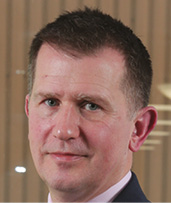
He has performed numerous roles within AES including Commercial Manager for Northern Ireland and Commercial Manager for Kilroot before being appointed Commercial Director for AES UK and Ireland. Before taking up his current role as President, Ian oversaw the company’s commercial strategy and operations across AES markets in Bulgaria, Jordan, Kazakhstan, the Netherlands and the UK and Ireland as Chief Commercial Officer for AES Europe.
Outside of work, Belfast-born Ian says that he likes to get outdoors with his wife Sarah and three young daughters Alice (4), Grace (3) and eight month-old Anna, who keep him busy.

